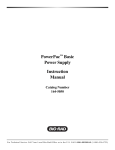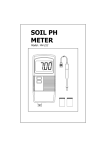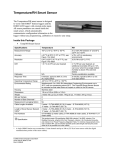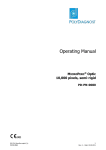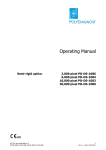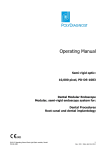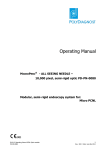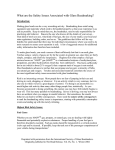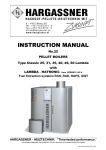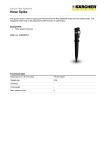Download pH ELECTRODE AND FLOW CELL INSTRUCTIONS - Bio-Rad
Transcript
pH ELECTRODE AND FLOW CELL INSTRUCTIONS CATALOG NUMBERS 750-0503 and 750-0504 The pH monitor is available as an option to the BioLogic HR System. It provides real-time monitoring of buffer pH and is designed for flow-through pH recordings. The flow cell is supplied with fittings for 1/16” OD tubing and is designed to work with the Signal Import Module - HR (SIM-HR), catalog number 7500502. The flow cell and pH electrode should be plumbed downstream of any backpressure device. These instructions cover the installation of the pH electrode and flow cell as well as maintenance of the pH electrode. Be sure to keep this information with your BioLogic HR User’s Manual for future reference. Figure 1. pH Electrode and Flow Cell pH Electrode Installation Connect the pH electrode to the top of the flow cell as follows: 1. Add a few mLs of buffer into the flow cell. This will serve as a lubricant for the electrode to easily be placed into the flow cell, thus minimizing the risk of breaking the porous glass surface of the electrode. 2. Slide the O-ring up the shaft of the electrode. 3. Insert the electrode onto the top of the flow cell and ensure that the O-ring rests against the sealing face of the flow cell. 4. Hand-tighten the nut onto the top of the flow cell; tighten the nut until some resistance is encountered. DO NOT OVERTIGHTEN. Overtightening will break the porous glass surface of the electrode. Page 1 of 4 Flow Cell Connections Since the flow cell is symmetrical, either port may be used as an inlet or outlet. The flow cell should be positioned such that the flow path is angled upward to promote bubble clearance. This is accomplished by rotating the flow cell so that the port used as the outlet is above the inlet port. Do not rotate the flow cell so much that the pH electrode is horizontal. Each port has 1/4-28 threads and may be used with flanged or non-flanged tubing. Install the tubing with the supplied flangeless fittings accordingly: 1. Use the tubing cutter supplied in the BioLogic HR Fittings Kit to cut the tubing. 2. Slide the nut onto the tubing (knurled end first). 3. Slip the ferrule, cone end first, onto the tubing until the tubing is flush with the face of the ferrule. 4. Hand-tighten the fitting into the port of the flow cell. 5. Screw the aluminum post into the flow cell. 6. Determine a convenient location for the pH monitor and mount it to the BioLogic rack. CONNECTION TO SIM-HR's pH PROBE CONNECTOR OUTLET PORT ANGLED FLOW PATH INLET PORT Figure 2. Electrical and Plumbing connections to the pH Monitor Electrode to the Signal Import Module-HR (SIM-HR) Connection To connect the pH electrode to the SIM-HR, simply insert the BNC connector from the pH electrode to the BNC port on the front of the SIM-HR and give it a quarter turn. Page 2 of 4 Specifications The flow cell is made of Kynar and has a swept volume of 50µL. The pH electrode is a Ag/AgCl double junction combination electrode consisting of both a pH electrode and a reference electrode built into a single body. The sealed reference design eliminates the need to add filling solutions and minimizes reference dryout. The double junction design includes a chamber filled with 3.5M KCl between the Ag/AgCl electrode and the flow stream. Consequently, this pH electrode is fully compatible with buffers (such as Tris) that would otherwise interact aberrantly with Ag/AgCl. pH Electrode Maintenance Information Helpful Operating Techniques 1. During shipment, the air bubble in the electrode’s stem may have moved into the bulb area. If bubbles are seen in the bulb area, hold the electrode by its top cap and shake downwards, as is done with a clinical thermometer. 2. Keep calibration and elution buffers at the same temperature. This will eliminate the need to correct values for temperature effects. 3. Allow sufficient time for the pH reading to stabilize. In general, buffers at low concentrations take longer to stabilize. 4. Do not expose the electrode to extreme pH solutions for prolonged periods of time. Doing so will severely shorten the lifespan of the electrode. 5. All pH electrodes age with time. Aging is characterized by slower speed of response. Aging is best detected by calibrating the electrode in buffer 7, then rinsing and placing the electrode in pH 4 buffer. As a rule, if the span is 10% or more in error (a reading of 4.3 or higher), then the electrode should either be cleaned or retested (see below). If performance is not restored, then the electrode should be replaced. pH Calibration and Measurements The frequency of calibration is a function of the electrode and the solutions it is exposed to. The electrode and SIM-HR (meter) should always be calibrated together, with the calibration frequency determined by experience. Use two buffers (for example pH 7 & 4 or pH 7 & 10) for calibration, as this will minimize errors. Use the step-wise procedure in the BioLogic software both for calibration and for sample measurements: 1. Remove the electrode from its soaker bottle and save the bottle. 2. Rinse the electrode by stirring it in water. The recessed bulb design actually allows the electrode to be used as a stirring rod. Stirring will bring solution to the electrode’s surface more quickly and will improve the speed of response. 3. Shake the electrode with a snap action to remove residual drops of solution. This will minimize carryover. 4. Stir the electrode in the first calibration buffer and allow the electrode to rest against the beaker’s wall. 5. From the Utilities drop down menu select “pH probe calibration.” (This selection is available only with BioLogic software version 2.0 or higher.) Follow the on-line instructions. Page 3 of 4 Electrode Storage When pH readings are made infrequently (i.e., several days or weeks apart), the electrode can be stored in its soaker bottle. The soaker bottle contains pH 4 buffer and potassium chloride. The electrode should remain in the bottle until it is used. Slide the cap onto the electrode, then the O-ring, and insert the electrode into the bottle and firmly tighten the cap. Should the solution in the soaker bottle need to be replaced, fill the bottle with pH 4 buffer and 3.5M potassium chloride. Electrode Cleaning A dirty pH bulb can lead to erroneous readings, including shortened span. The type of foreign material coating the bulb will determine the cleaning technique. Soft coatings can be removed by vigorous stirring or by use of a squirt bottle. Organic chemical or hard coatings should be chemically removed. Only in extreme cases should the bulb be mechanically cleaned, as abrasion can lead to permanent damage. If cleaning does not restore performance, reconditioning may be tried. Reconditioning When reconditioning is required due to electrode aging, the following chemical treatments can be tried. They are presented in the order of the severity of their attack on the pH glass and may not improve (and in some cases actually further deteriorate) electrode performance. NOTE: Use proper precautions when handling these hazardous chemicals. Ammonium bifluoride (NH4F•HF) and hydrofluoric acid (HF) are extremely hazardous and should only be used by qualified personnel. 1. Immerse the electrode tip in 0.1N HCl for 15 seconds, rinse with water, and then immerse the tip in 0.1N NaOH for 15 seconds and rinse in tap water. Repeat this sequence three times, and then recheck the electrode performance. If performance has not been restored, try Step 2. 2. Immerse the tip in a 20% solution of NH4F•HF for 2 or 3 minutes, rinse with water and recheck performance. If performance has not been restored, try Step 3. 3. Immerse the electrode tip in 5% HF for 10 to 15 seconds, rinse well in water, quickly rinse in 5N HCl, rinse well in water, and recheck performance. If performance has not been restored, replace the electrode. Technical Assistance For additional help, contact your local Bio-Rad representative. In the United States, call Technical Services at 1-800-4BIORAD. Ordering Information 750-0502 Signal Import Module - HR 750-0503 pH electrode, replacement 750-0504 Flow Cell, replacement 750-0505 BioLogic HR pH Monitor Page 4 of 4 4106108 Rev C




